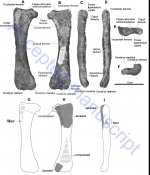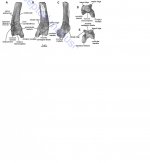Fred Ruhe
Well-known member

Hirotsugu Mori & Kazunori Miyata, 2020
Early Plotopteridae specimens (Aves) from the Itanoura and Kakinoura Formations (latest Eocene to early Oligocene), Saikai, Nagasaki Prefecture, western Japan
Paleontological Research in press
oi:10.2517/2020PR018
Abstract and pdf: http://www.palaeo-soc-japan.jp/publications/pr/2020PR018_Mori_Miyata.pdf
Plotopterids, commonly known as “penguin-like birds”, are wing-propelled diving birds known from the latest Eocene to middle Miocene in the eastern and western Pacific Rim. Here, we describe two new specimens of the family Plotopteridae, a right femur from the Itanoura Formation (latest Eocene to earliest Oligocene), and a distal half of a right tibiotarsus from the Kakinoura Formation (early Oligocene), both at the lower part of the Nishisonogi Group, Saikai City, Nagasaki Prefecture, Kyushu, southwestern Japan. The femur is slightly younger than or potentially as old as the earliest plotopterid known from Japan and the U.S.A. CT scanning revealed that it has a dense cortical bone, justifying its taxonomic assignment to the family Plotopteridae. It resembles the femur of Olympidytes, which is endemic to North America previously, in its femoral neck, well developed trochanter femoris, and straight facies articularis antitrochanterica, but is not assignable to any known genus. The tibiotarsus resembles that of Olympidytes in the presence of a well-developed trochlea catilaginis tibialis, a large embossment lateral to the pons supratendineus, and a deep incisura intercondylaris, and therefore referable to Olympidytes. The possibility of hindlimb-propelled diving in the family Plotopteidae was also discussed. These new specimens suggest the early diversity of the family in Japan was higher than previously thought.
Enjoy,
Fred
Early Plotopteridae specimens (Aves) from the Itanoura and Kakinoura Formations (latest Eocene to early Oligocene), Saikai, Nagasaki Prefecture, western Japan
Paleontological Research in press
oi:10.2517/2020PR018
Abstract and pdf: http://www.palaeo-soc-japan.jp/publications/pr/2020PR018_Mori_Miyata.pdf
Plotopterids, commonly known as “penguin-like birds”, are wing-propelled diving birds known from the latest Eocene to middle Miocene in the eastern and western Pacific Rim. Here, we describe two new specimens of the family Plotopteridae, a right femur from the Itanoura Formation (latest Eocene to earliest Oligocene), and a distal half of a right tibiotarsus from the Kakinoura Formation (early Oligocene), both at the lower part of the Nishisonogi Group, Saikai City, Nagasaki Prefecture, Kyushu, southwestern Japan. The femur is slightly younger than or potentially as old as the earliest plotopterid known from Japan and the U.S.A. CT scanning revealed that it has a dense cortical bone, justifying its taxonomic assignment to the family Plotopteridae. It resembles the femur of Olympidytes, which is endemic to North America previously, in its femoral neck, well developed trochanter femoris, and straight facies articularis antitrochanterica, but is not assignable to any known genus. The tibiotarsus resembles that of Olympidytes in the presence of a well-developed trochlea catilaginis tibialis, a large embossment lateral to the pons supratendineus, and a deep incisura intercondylaris, and therefore referable to Olympidytes. The possibility of hindlimb-propelled diving in the family Plotopteidae was also discussed. These new specimens suggest the early diversity of the family in Japan was higher than previously thought.
Enjoy,
Fred





